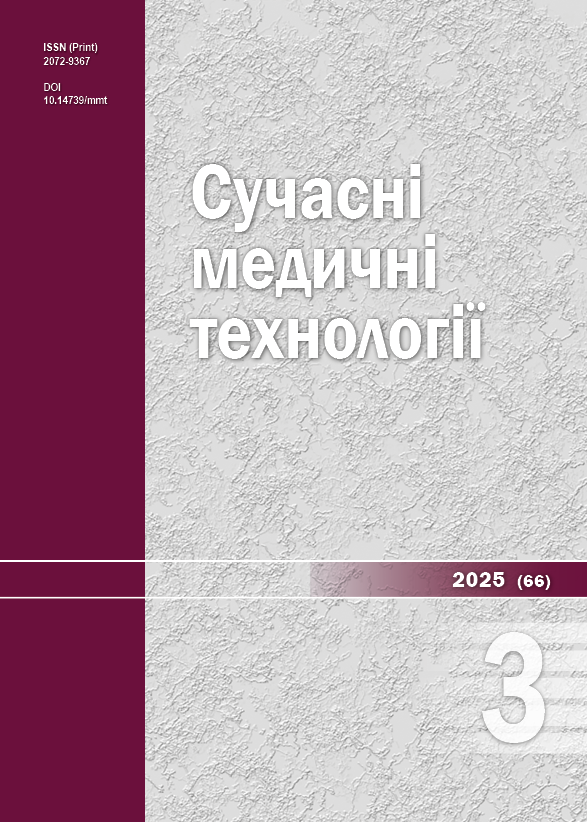Apixaban in glomerulonephritis with nephrotic syndrome: thromboprophylaxis and pleiotropic effects in a prospective cohort study
DOI:
https://doi.org/10.14739/mmt.2025.3.335542Keywords:
apixaban, nephrotic syndrome, glomerulonephritis, thromboprophylaxis, inflammation, fibrosis, anticoagulation, biomarkersAbstract
Aim: to assess the efficacy and safety of apixaban in preventing thromboembolic complications in patients with nephrotic syndrome (NS) due to primary glomerulonephritis, and to investigate its potential anti-inflammatory and antifibrotic effects.
Materials and methods. A prospective longitudinal cohort study included 85 adult patients with newly diagnosed NS and estimated glomerular filtration rate >60 mL/min/1.73 m2. Patients were divided into two groups: 42 received warfarin and 43 received apixaban (5 mg twice daily). The follow-up period was 6 months. IL-6, TNFα, and TGF-β1 were measured in serum and urine at baseline, 1 month, and 6 months.
Results. No thromboembolic events occurred in either group. Minor bleeding events were significantly more common in the warfarin group (p = 0.01), confirming apixaban’s better safety profile. After 6 months, the apixaban group showed a more pronounced decrease in IL-6, TNFα, and TGF-β1 levels in both serum and urine compared to the warfarin group (p < 0.05), suggesting anti-inflammatory and antifibrotic effects potentially associated with protease-activated receptor pathway modulation.
Conclusions. Apixaban ensures safe and effective thromboprophylaxis in NS with possible additional benefits in reducing inflammation and fibrosis. Further studies are needed to confirm these effects and define its role in nephrology.
References
Dudar I, Mykhaloiko I. [The role of hemostatic disorders in the progression of chronic kidney disease]. Ukrainian Journal of Nephrology and Dialysis. 2019;4(64):49-55. Ukrainian. doi: https://doi.org/10.31450/ukrjnd.4(64).2019.07
De Pascali F, Brunini F, Rombolà G, Squizzato A. Efficacy and safety of prophylactic anticoagulation in patients with primary nephrotic syndrome: a systematic review and meta-analysis. Intern Med J. 2024;54(2):214-23. doi: https://doi.org/10.1111/imj.16227
Ageno W, Caramelli B, Donadini MP, Girardi L, Riva N. Changes in the landscape of anticoagulation: a focus on direct oral anticoagulants. Lancet Haematol. 2024;11(12):e938-e950. doi: https://doi.org/10.1016/S2352-3026(24)00281-3
Dudar I, Mykhaloiko I. [Anticoagulant and antiplatelet therapy for chronic kidney disease patients]. Ukrainian Journal of Nephrology and Dialysis. 2020;2(66):40-6. Ukrainian. doi: https://doi.org/10.31450/ukrjnd.2(66).2020.06 не працює https://ukrjnd.com.ua/index.php/journal/article/view/409
Nissar SM, Kuchay AA, Mir TH, Goud LN, Latief M. Direct Oral Anticoagulants in Nephrotic Syndrome: Our Experience and Literature Review. Indian J Nephrol. 2024;34(2):169-71. doi: https://doi.org/10.4103/ijn.ijn_317_22
Kidney Disease: Improving Global Outcomes (KDIGO) Glomerular Diseases Work Group. KDIGO 2021 Clinical Practice Guideline for the Management of Glomerular Diseases. Kidney Int. 2021;100(4S):S1-S276. doi: https://doi.org/10.1016/j.kint.2021.05.021
Xu R, Wu F, Lan J, Duan P. Real-world comparison of direct-acting oral anticoagulants and vitamin K antagonists in chronic kidney disease: a systematic review and meta-analysis. Expert Rev Hematol. 2021;14(5):493-502. doi: https://doi.org/10.1080/17474086.2021.1920012
Jannati S, Patnaik R, Banerjee Y. Beyond Anticoagulation: A Comprehensive Review of Non-Vitamin K Oral Anticoagulants (NOACs) in Inflammation and Protease-Activated Receptor Signaling. Int J Mol Sci. 2024;25(16):8727. doi: https://doi.org/10.3390/ijms25168727
Esmon CT. Targeting factor Xa and thrombin: impact on coagulation and beyond. Thromb Haemost. 2014;111(4):625-33. doi: https://doi.org/10.1160/TH13-09-0730
Russo V, Falco L, Tessitore V, Mauriello A, Catapano D, Napolitano N, et al. Anti-Inflammatory and Anticancer Effects of Anticoagulant Therapy in Patients with Malignancy. Life (Basel). 2023;13(9):1888. doi: https://doi.org/10.3390/life13091888
Mykhaloiko IS, Yatsyshyn RI, Dudar IO, Hotsaniuk OI, Kuryliv HM. Safety and efficacy of apixaban in patients with glomerulonephritis and nephrotic syndrome: a prospective longitudinal cohort study. Modern Medical Technology. 2025;17(1):41-5. doi: https://doi.org/10.14739/mmt.2025.1.320766
Atzemian N, Kareli D, Ragia G, Manolopoulos VG. Distinct pleiotropic effects of direct oral anticoagulants on cultured endothelial cells: a comprehensive review. Front Pharmacol. 2023;14:1244098. doi: https://doi.org/10.3389/fphar.2023.1244098
Frost C, Nepal S, Wang J, Schuster A, Byon W, Boyd RA, et al. Safety, pharmacokinetics and pharmacodynamics of multiple oral doses of apixaban, a factor Xa inhibitor, in healthy subjects. Br J Clin Pharmacol. 2013;76(5):776-86. doi: https://doi.org/10.1111/bcp.12106
Heuberger DM, Schuepbach RA. Protease-activated receptors (PARs): mechanisms of action and potential therapeutic modulators in PAR-driven inflammatory diseases. Thromb J. 2019;17:4. doi: https://doi.org/10.1186/s12959-019-0194-8. Erratum in: Thromb J. 2019;17:22. doi: https://doi.org/10.1186/s12959-019-0212-x
Lin R, McDonald G, Jolly T, Batten A, Chacko B. A Systematic Review of Prophylactic Anticoagulation in Nephrotic Syndrome. Kidney Int Rep. 2019;5(4):435-47. doi: https://doi.org/10.1016/j.ekir.2019.12.001
Hamanaka Y, Sotomi Y, Hirata A, Hirayama A, Higuchi Y. P3471Anti-inflammatory effects of direct oral anticoagulants in patients with non-valvular atrial fibrillation: insights from 2216 patients in the DIRECT registry. Eur Heart J. 2019;40(Suppl_1):ehz745.0343. doi: https://doi.org/10.1093/eurheartj/ehz745.0343
Guillou S, Beaumont J, Tamareille S, Giraud S, Mirebeau-Prunier D, Prunier F, et al. Direct Rivaroxaban-Induced Factor XA Inhibition Proves to be Cardioprotective in Rats. Shock. 2020;53(6):730-6. doi: https://doi.org/10.1097/shk.0000000000001412
Papadaki S, Sidiropoulou S, Moschonas IC, Tselepis AD. Factor Xa and thrombin induce endothelial progenitor cell activation. The effect of direct oral anticoagulants. Platelets. 2021;32(6):807-14. doi: https://doi.org/10.1080/09537104.2020.1802413
Villari A, Giurdanella G, Bucolo C, Drago F, Salomone S. Apixaban Enhances Vasodilatation Mediated by Protease-Activated Receptor 2 in Isolated Rat Arteries. Front Pharmacol. 2017;8:480. doi: https://doi.org/10.3389/fphar.2017.00480
Torramade-Moix S, Palomo M, Vera M, Jerez D, Moreno-Castaño AB, Zafar MU, et al. Apixaban Downregulates Endothelial Inflammatory and Prothrombotic Phenotype in an In Vitro Model of Endothelial Dysfunction in Uremia. Cardiovasc Drugs Ther. 2021;35(3):521-32. doi: https://doi.org/10.1007/s10557-020-07010-z
Derebail VK, Greenberg KR, Anderson AM, Stearman K, Ginsberg LJ, Falk RJ. Pharmacokinetics and pharmacodynamics of apixaban in nephrotic syndrome: findings from a phase 1a trial. Am J Kidney Dis. 2023;81(3):373-6 doi: https://doi.org/10.1053/j.ajkd.2022.09.011
Downloads
Additional Files
Published
How to Cite
Issue
Section
License
Copyright (c) 2025 I. S. Mykhaloiko, R. I. Yatsyshyn, N. V. Cherniuk, V. Ya. Kaminskyi, M. Ya. Humeniuk

This work is licensed under a Creative Commons Attribution-NonCommercial 4.0 International License.
The work is provided under the terms of the Public Offer and of Creative Commons Attribution-NonCommercial 4.0 International (CC BY-NC 4.0). This license allows an unlimited number of persons to reproduce and share the Licensed Material in all media and formats. Any use of the Licensed Material shall contain an identification of its Creator(s) and must be for non-commercial purposes only.














